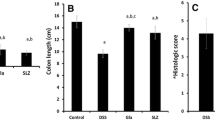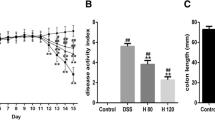Abstract
Hydrogen sulfide (H2S) is an endogenous mediator that contributes to many important physiological processes including vasodilation and vascular smooth muscle relaxation; in turn, preventing tissue damage and reducing inflammation. Heme oxygenase (HO) enzymes, of which HO-1 is inducible by harmful stimuli, were found to regulate intestinal inflammation in experimental animal models of colitis. We aimed to investigate the protective effects of H2S against 2,4,6-trinitrobenzenesulfonic acid (TNBS)-induced colitis in rats, and whether HO enzyme system is involved in the H2S-induced colonic cytoprotection. Male Wistar rats were treated with TNBS to induce colitis, and H2S donor (Lawesson’s reagent) was prepared two times/day at different concentrations, and delivered per os (from day 1 to day 3). Our results suggest that daily treatment (2 times/day) with H2S donor, could significantly decrease the extent of colonic inflammation compared to vehicle treatment, and the most effective daily dose of H2S donor against inflammation was 18.75 µM/kg/day. Per os administration of H2S donor increased the colonic HO enzyme activity; on the contrary, the protective effect of H2S was abolished by the co-treatment with HO inhibitor. Our findings suggest that H2S confers colonoprotection, probably by modulation of anti-inflammatory parameters and HO enzyme activity.







Similar content being viewed by others
References
Abe K, Kimura H (1996) The possible role of hydrogen sulfide as an endogenous neuromodulator. J Neurosci 16(3):1066–1071
Badiei A et al (2016) Cystathionine-gamma-lyase gene silencing with siRNA in monocytes/macrophages attenuates inflammation in cecal ligation and puncture-induced sepsis in the mouse. J Biosci 41(1):87–95
Bai AP et al (2005) Diallyl trisulfide inhibits tumor necrosis factor-alpha expression in inflamed mucosa of ulcerative colitis. Dig Dis Sci 50(8):1426–1431
Balaha M et al (2016) Garlic oil inhibits dextran sodium sulfate-induced ulcerative colitis in rats. Life Sci 146:40–51
Biancone L et al (2007) Treatment with biologic therapies and the risk of cancer in patients with IBD. Nat Clin Pract Gastroenterol Hepatol 4(2):78–91
Blackler R et al (2012) Gastrointestinal-sparing effects of novel NSAIDs in rats with compromised mucosal defence. PLoS ONE 7(4):e35196
Blackler RW et al (2014) NSAID-gastroenteropathy: new aspects of pathogenesis and prevention. Curr Opin Pharmacol 19:11–16
Blackler RW et al (2015) Hydrogen sulphide protects against NSAID-enteropathy through modulation of bile and the microbiota. Br J Pharmacol 172(4):992–1004
Bradley PP et al (1982) Measurement of cutaneous inflammation: estimation of neutrophil content with an enzyme marker. J Invest Dermatol 78(3):206–209
Chen X, Liu XS (2016) Hydrogen sulfide from a NaHS source attenuates dextran sulfate sodium (DSS)-induced inflammation via inhibiting nuclear factor-kappaB. J Zhejiang Univ Sci B 17(3):209–217
Coletta C, Szabo C (2013) Potential role of hydrogen sulfide in the pathogenesis of vascular dysfunction in septic shock. Curr Vasc Pharmacol 11(2):208–221
Davila L, Ranganathan P (2011) Pharmacogenetics: implications for therapy in rheumatic diseases. Nat Rev Rheumatol 7(9):537–550
Delisa JA, DeLateur BJ (1983) Therapeutic exercise: types and indications. Am Fam Phys 28(4):227–233
Desreumaux P, Ghosh S (2006) Review article: mode of action and delivery of 5-aminosalicylic acid - new evidence. Aliment Pharmacol Ther 24(Suppl 1):2–9
Distrutti E et al (2006) Evidence that hydrogen sulfide exerts antinociceptive effects in the gastrointestinal tract by activating KATP channels. J Pharmacol Exp Ther 316(1):325–335
Dufton N et al (2012) Hydrogen sulfide and resolution of acute inflammation: a comparative study utilizing a novel fluorescent probe. Scientific Reports 2:499
Erbil Y et al (2007) Effect of heme oxygenase-1 induction by octreotide on TNBS-induced colitis. J Gastroenterol Hepatol 22(11):1852–1858
Fiorucci S et al (2006) The emerging roles of hydrogen sulfide in the gastrointestinal tract and liver. Gastroenterology 131(1):259–271
Fiorucci S et al (2007) Enhanced activity of a hydrogen sulphide-releasing derivative of mesalamine (ATB-429) in a mouse model of colitis. Br J Pharmacol 150(8):996–1002
Flannigan KL et al (2013) Enhanced synthesis and diminished degradation of hydrogen sulfide in experimental colitis: a site-specific, pro-resolution mechanism. PLoS ONE 8(8):e71962
Flannigan KL et al (2014) Impaired hydrogen sulfide synthesis and IL-10 signaling underlie hyperhomocysteinemia-associated exacerbation of colitis. Proc Natl Acad Sci USA 111(37):13559–13564
Gemici B, Wallace JL (2015) Anti-inflammatory and cytoprotective properties of hydrogen sulfide. Methods Enzymol 555:169–193
Ghatule RR et al (2014) Protective effects of Aegle marmelos fruit pulp on 2,4,6-trinitrobenzene sulfonic acid-induced experimental colitis. Pharmacogn Magazine 10(Suppl 1):S147–S152
Horvath K et al (2008) The involvement of heme oxygenase-1 activity in the therapeutic actions of 5-aminosalicylic acid in rat colitis. Eur J Pharmacol 581(3):315–323
Kashiba M et al (2002) From O2 to H2S: a landscape view of gas biology. Keio J Med 51(1):1–10
Lane ER et al (2017) The microbiota in inflammatory bowel disease: current and therapeutic insights. J Inflamm Res 10:63–73
Liu H et al (2009) Hydrogen sulfide protects from intestinal ischaemia-reperfusion injury in rats. J Pharm Pharmacol 61(2):207–212
Lo Faro ML et al (2014) Hydrogen sulfide and nitric oxide interactions in inflammation. Nitric Oxide 41:38–47
Magierowski M et al (2015) Gaseous mediators nitric oxide and hydrogen sulfide in the mechanism of gastrointestinal integrity, protection and ulcer healing. Molecules 20(5):9099–9123
Maines MD (2005) The heme oxygenase system: update 2005. Antioxid Redox Signal 7(11–12):1761–1766
Motta JP et al (2015) Hydrogen sulfide protects from colitis and restores intestinal microbiota biofilm and mucus production. Inflamm Bowel Dis 21(5):1006–1017
Motterlini R et al (2002) Regulation of heme oxygenase-1 by redox signals involving nitric oxide. Antioxid Redox Signal 4(4):615–624
Neurath MF (2014) Cytokines in inflammatory bowel disease. Nat Rev Immunol 14(5):329–342
Otterbein LE et al (2000) Carbon monoxide has anti-inflammatory effects involving the mitogen-activated protein kinase pathway. Nat Med 6(4):422–428
Oyagi A et al (2010) Protective effects of a gastrointestinal agent containing Korean red ginseng on gastric ulcer models in mice. BMC Complement Alternative Med 10:45
Pae HO, Chung HT (2009) Heme oxygenase-1: its therapeutic roles in inflammatory diseases. Immune Netw 9(1):12–19
Schicho R et al (2006) Hydrogen sulfide is a novel prosecretory neuromodulator in the Guinea-pig and human colon. Gastroenterology 131(5):1542–1552
Sparatore A et al (2011) Therapeutic potential of new hydrogen sulfide-releasing hybrids. Expert Rev Clin Pharmacol 4(1):109–121
Stipanuk MH, Beck PW (1982) Characterization of the enzymic capacity for cysteine desulphhydration in liver and kidney of the rat. Biochem J 206(2):267–277
Szabo C (2007) Hydrogen sulphide and its therapeutic potential. Nat Rev Drug Discov 6(11):917–935
Szabo C, Papapetropoulos A (2011) Hydrogen sulphide and angiogenesis: mechanisms and applications. Br J Pharmacol 164(3):853–865
Szalai Z et al (2014) Anti-inflammatory effect of recreational exercise in TNBS-induced colitis in rats: role of NOS/HO/MPO system. Oxid Med Cell Longev 2014:925981
Teague B et al (2002) The smooth muscle relaxant effect of hydrogen sulphide in vitro: evidence for a physiological role to control intestinal contractility. Br J Pharmacol 137(2):139–145
Tenhunen R et al (1968) The enzymatic conversion of heme to bilirubin by microsomal heme oxygenase. Proc Natl Acad Sci USA 61(2):748–755
Triantafillidis JK et al (2014) Effect of mesalamine and prednisolone on TNBS experimental colitis, following various doses of orally administered iron. Biomed Res Int 2014:648535
Uddin MJ et al (2013) Carbon monoxide attenuates dextran sulfate sodium-induced colitis via inhibition of GSK-3beta signaling. Oxid Med Cell Longev 2013:210563
Varga C et al (2007) Modulation by heme and zinc protoporphyrin of colonic heme oxygenase-1 and experimental inflammatory bowel disease in the rat. Eur J Pharmacol 561(1–3):164–171
Wallace JL (2012) NSAID gastropathy and enteropathy: distinct pathogenesis likely necessitates distinct prevention strategies. Br J Pharmacol 165(1):67–74
Wallace JL, Wang R (2015) Hydrogen sulfide-based therapeutics: exploiting a unique but ubiquitous gasotransmitter. Nat Rev Drug Discov 14(5):329–345
Wallace JL et al (2007) Hydrogen sulfide enhances ulcer healing in rats. FASEB J 21(14):4070–4076
Wallace JL et al (2009) Endogenous and exogenous hydrogen sulfide promotes resolution of colitis in rats. Gastroenterology 137(2):569-578, 578 e561
Wang WP et al (2001) Protective role of heme oxygenase-1 on trinitrobenzene sulfonic acid-induced colitis in rats. Am J Physiol Gastrointest Liver Physiol 281(2):G586–G594
Williams C et al (2011) Optimizing clinical use of mesalazine (5-aminosalicylic acid) in inflammatory bowel disease. Therap Adv Gastroenterol 4(4):237–248
Zhang H et al (2007) Endogenous hydrogen sulfide regulates leukocyte trafficking in cecal ligation and puncture-induced sepsis. J Leukoc Biol 82(4):894–905
Zhang H et al (2008) Endogenous hydrogen sulfide regulates inflammatory response by activating the ERK pathway in polymicrobial sepsis. J Immunol 181(6):4320–4331
Zhong W et al (2010) Hemin exerts multiple protective mechanisms and attenuates dextran sulfate sodium-induced colitis. J Pediatric Gastroenterol Nutr 50(2):132–139
Acknowledgements
This research was realized in the frames of TÁMOP 4.2.4. A/2-11-1-2012-0001 National Excellence Program—Elaborating and operating an inland student and researcher personal support system. The project was subsidized by the European Union and co-financed by the European Social Fund (Krisztina Kupai). It was supported also by the ÚNKP-ÚNKP-16-4 New National Excellence Program of the Ministry of Human Capacities (Anikó Pósa) and GINOP-2.3.2-15-2016-00030.
Author information
Authors and Affiliations
Corresponding author
Ethics declarations
Conflict of interest
The authors declare that there are no conflicts of interests regarding the publication of this paper.
Rights and permissions
About this article
Cite this article
Kupai, K., Almási, N., Kósa, M. et al. H2S confers colonoprotection against TNBS-induced colitis by HO-1 upregulation in rats. Inflammopharmacol 26, 479–489 (2018). https://doi.org/10.1007/s10787-017-0382-8
Received:
Accepted:
Published:
Issue Date:
DOI: https://doi.org/10.1007/s10787-017-0382-8




